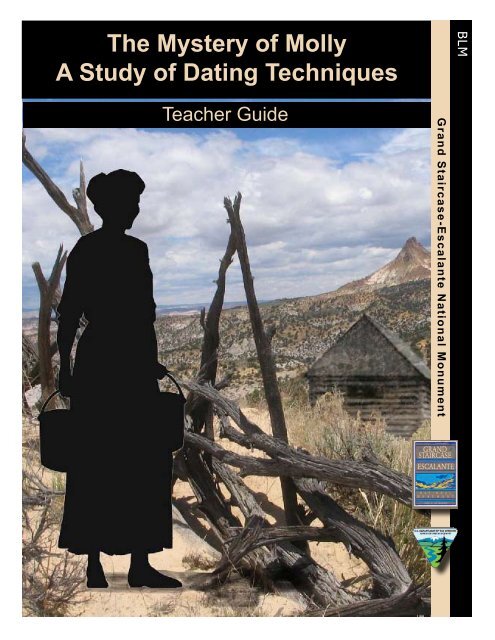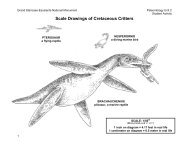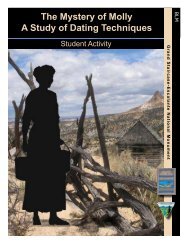A Study of Dating Techniques - Gsenmschool.org
A Study of Dating Techniques - Gsenmschool.org
A Study of Dating Techniques - Gsenmschool.org
- No tags were found...
You also want an ePaper? Increase the reach of your titles
YUMPU automatically turns print PDFs into web optimized ePapers that Google loves.
The Mystery <strong>of</strong> MollyA <strong>Study</strong> <strong>of</strong> <strong>Dating</strong> <strong>Techniques</strong>BLMTeacher GuideGrand Staircase-Escalante National Monument
Grand Staircase Escalante National Monument Archaeology Unit 1Teacher GuideGrade Level9-12 and 7-8 (with adaptations)Duration45 Minutes as a team or group activity90 Minutes for individual studentsThe Mystery <strong>of</strong> MollyA <strong>Study</strong> <strong>of</strong> <strong>Dating</strong> <strong>Techniques</strong>DescriptionStudents investigate absolute and relative dating techniques used by scientists to date historicsites and artifacts and apply them to a mysterious, fictional excavation.Goals• Compare and contrast absolute and relative dating• Evaluate the physical evidence from a fictional cold case and determine the absolute orrelative dating techniques that could be used to solve the mystery.Academic Content StandardsThe following standards are drawn from Content Knowledge. 1World History Standard 1Understands the biological and cultural processes that shaped the earliest humancommunities.Level IV (Grades 9-12)Benchmark 1.Understands the methods by which early human communities are studiedand what these studies reveal (e.g., the way in which newly discovered sitesand investigative techniques used to examine them affect the study andunderstanding <strong>of</strong> human evolution, how common refuse can be studied tomake inferences about earlier communities.Benchmark 2.Understands how different kinds <strong>of</strong> evidence are used to determine thecultural characteristics <strong>of</strong> early human communities (e.g., how archaeologicalevidence demonstrates the influences <strong>of</strong> climate, geographic location, andeconomic specialization on everyday life; how nonverbal evidence such asburials, carvings, and paintings can indicate the presence <strong>of</strong> religion)Level III (Grades 7-8)Benchmark 1.Understands early hominid development and scientific methods used todetermine the dates and evolution <strong>of</strong> different human communities (e.g.,methods employed by archaeologists, geologists, and anthropologists tostudy hominid evolution)1 Content Knowledge: A Compendium <strong>of</strong> Standards and Benchmarks for K-12 Education: 4 th Edition, Mid-Continent Research forEducation and Learning in Aurora, Colorado. http://www.mcrel.<strong>org</strong>/standards-benchmarks/1
Grand Staircase Escalante National Monument Archaeology Unit 1Teacher GuidePhysical Science Standard 8Understands the structure and properties <strong>of</strong> matterLevel IV (Grades 9-12)Benchmark 8.Knows how radioactive isotopes can be used to estimate the age <strong>of</strong> materialsthat contain them because radioactive isotopes undergo spontaneous nuclearreactions and emit particles and/or wavelike radiation; the decay <strong>of</strong> any onenucleus cannot be predicted, but a large group <strong>of</strong> identical nuclei decay at apredictable rate, which can be used to estimate the material’s age.Nature <strong>of</strong> Science Standard 11Understands the nature <strong>of</strong> scientific knowledgeLevel IV (Grade 9-12)Benchmark 3Understands how scientific knowledge changes and accumulates over time(e.g., all scientific knowledge is subject to change as new evidence becomesavailable; some scientific ideas are incomplete and opportunity exists in theseareas for new advances; theories are continually tested, revised, andoccasionally discarded)Benchmark 4Knows that from time to time, major shifts occur in the scientific view <strong>of</strong>how the world works, but usually the changes that take place in the body <strong>of</strong>scientific knowledge are small modifications <strong>of</strong> prior knowledge.Materials• The Mystery <strong>of</strong> Molly – Student Activity• Computer with Internet access – if time allows for internet research.• Video or DVD Traces in Time, produced by GSENMObjectives1. Investigate different methods <strong>of</strong> Absolute and Relative <strong>Dating</strong> to see how they could beapplied in The Mystery <strong>of</strong> Molly.2. Use information obtained from Absolute and Relative <strong>Dating</strong> to write a resolution to TheMystery <strong>of</strong> Molly.ProceduresThis activity will take 90 minutes if done by individual students. To complete the activity in45 minutes students can work in teams or small groups. The video or DVD Traces in Time isa great way to introduce students to the Grand Staircase-Escalante National Monument.1. This activity begins with a fictional story that sets up the “forensic cold case” <strong>of</strong> TheMystery <strong>of</strong> Molly. Individual students can read through this introduction quickly.2. Step 1 – Absolute <strong>Dating</strong> and Relative <strong>Dating</strong> (pages 2-7), consists <strong>of</strong> a series <strong>of</strong> shortintroductions to different dating techniques, followed by internet links and questions toreview each methodology. The internet links can be checked out in class or at home.Students can work individually or in groups to speed the activity up.2
Grand Staircase Escalante National Monument Archaeology Unit 1Teacher Guide3. In Step 2 – The Final Step (page 8), individual students have the chance to be creativeforensic experts. After assessing the data individual students write their own hypothesesabout the fictional cold case <strong>of</strong> “Molly”. To save time with the unit this objective can beassigned as homework.Adaptations:This activity is appropriate for both 9-12 grades and 7-8. If used at the 7-8 level it would bemore effective to complete Objective 1 as a class.Extensions• Archaeology Unit 2, Prehistoric Cultures <strong>of</strong> GSENM, deals with Seriation.• Students can research other methods <strong>of</strong> absolute dating online at these websites:Obsidian Hydration – Minnesota State Universityhttp://www.mnsu.edu/emuseum/archaeology/dating/dat_obsid.htmlLithic Analysis & Obsidian Hydration Laboratory –UCLAhttp://merton.sscnet.ucla.edu/ioa/labs/lithics/lithics.htmlChronometric <strong>Techniques</strong> – Potassium-Argon <strong>Dating</strong>http://anthro.palomar.edu/time/time_5.htmChronometric <strong>Techniques</strong> – Luminescence <strong>Dating</strong>http://anthro.palomar.edu/time/time_5.htmReferencesBooksBandelier, Adolf F, The Delight Makers, Harcourt Brace Jovanovich, Publishers, 1971Bryson, Bill A Short History <strong>of</strong> Nearly Everything, New York; Broadway Books, 2003Chesher, Greer K., Heart <strong>of</strong> the Desert Wild, Grand Staircase-Escalante NationalMonument, Bryce Canyon, Utah; Bryce Canyon National History Association,2000.Rutter Michael, Outlaw Tales <strong>of</strong> Utah, Globe Pequot Press, 2003.WebsitesAbout.com – Archaeologyhttp://archaeology.about.com/od/dating/About.com – Chemistryhttp://chemistry.about.com/od/workedchemistryproblems/a/c14dating.htmChronological Methods, University <strong>of</strong> California, Santa Barbarahttp://id-archserve.ucsb.edu/Anth3/Courseware/Chronology/01_Contents.htmlDendrochronology <strong>of</strong> Bristle Cone Pineshttp://www.sonic.net/bristlecone/dendro.html3
Grand Staircase Escalante National Monument Archaeology Unit 1Teacher GuideHistory Detectives – Timber <strong>Dating</strong>http://www.pbs.<strong>org</strong>/opb/historydetectives/techniques/timber.htmlLithic Analysis & Obsidian Hydration laboratory – UCLAhttp://merton.sscnet.ucla.edu/ioa/labs/lithics/lithics.htmlMesa Verde national Park – Artifacts Collectionhttp://www.nps.gov/meve/edu_resources/artifacts/index.htmNova Online – The <strong>Dating</strong> Gamehttp://www.pbs.<strong>org</strong>/wgbh/nova/first/radiocarbon.htmlObsidian Hydration – Minnesota State Universityhttp://www.mnsu.edu/emuseum/archaeology/dating/dat_obsid.htmlRecord <strong>of</strong> Time: Chronometric <strong>Techniques</strong> – Dendrochronologyhttp://anthro.palomar.edu/time/Default.htmSouth Dakota State Historical Society Archaeological Resource Center – Artifactshttp://www.sdsmt.edu/wwwsarc/collectn/collectn.htmlTree Ring <strong>Dating</strong> from Waynes Word – An On-Line Textbook <strong>of</strong> Natural Historyhttp://waynesword.palomar.edu/treedate.htmAssessmentThe writing assignment in Step 2 – The Final Step, Question 8 (page 8), can be assessed todetermine whether or not students understand the five methods <strong>of</strong> dating used byarchaeologists well enough to apply the clues and come up with viable theories about the lifeand times <strong>of</strong> Mystery Molly.Answer KeyQuestion 1Which <strong>of</strong> the artifacts unearthed by archeologists would be chronological markers?The metal box, the letters, and possibly the broken chinaQuestion 2The pattern on the broken pottery was traced to a company in England that made chinafrom 1752-1882 and sold the pattern found at the dig for 12 years, from 1860-1872. Wouldthis be a chronological marker? If so, what information would this give you about the coldcase?The date the china was sold indicates that it was purchased after 1860.Question 3A few <strong>of</strong> the beams were in good enough condition that they were sent to thedendrochronology lab. Scientists in the lab match the growth rings <strong>of</strong> the charred beams tocharts made from other trees in the region. The tree had been cut down in 1880. What doesthe information tell you about the excavated house?4
Grand Staircase Escalante National Monument Archaeology Unit 1Teacher GuideVocabularyArchaeologistAnthropologistFlint-knappingObsidianSeriationStratigraphyOne who studies past human life and culture by therecovering and examination <strong>of</strong> remaining materialevidence, such as graves, buildings, tools, and pottery.One who studies the origin, the behavior, and the physical,social, and cultural development <strong>of</strong> humans.The activity, largely carried out by prehistoric people, <strong>of</strong>chipping and splitting flint to make tools.A jet-black volcanic glass, chemically similar to granite andformed by the rapid cooling <strong>of</strong> molten lava, that was usedby early civilizations for manufacturing tools and ceremonialobjects.Arrangement or position in a series.The study <strong>of</strong> rock strata, especially the distribution,deposition, and age <strong>of</strong> sedimentary rocks.6





